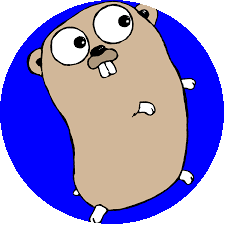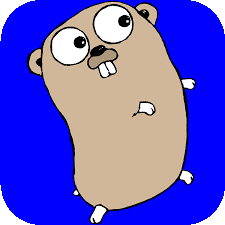在开发中,有时会遇到对图片的处理需求,在 Python中, PIL/Pillow 库非常强大和易用。
而 Golang 语言中,处理图片的标准库 image也可以实现一些基本操作。
image 库支持常见的 PNG、JPEG、GIF 等格式的图片处理, 可以对图片进行读取、裁剪、绘制、生成等操作。
读取
图片的读取,和文件的读取类似,只需要使用 os.Open()函数,获取一个输入流,然后将数据流进行解码操作。
需要注意的是,在解码阶段,要将不同类型的图片的解码器先进行注册,这样才不会报unknown format 的错误。
package mainimport ("fmt""image"_ "image/png""os")func main() {f, err := os.Open("./gopher.png")if err != nil {panic(err)}img, formatName, err := image.Decode(f)if err != nil {panic(err)}fmt.Println(formatName)fmt.Println(img.Bounds())fmt.Println(img.ColorModel())}
Decode方法返回的第一个值是一个 image.Image类型接口。不同的颜色模型的图片返回不同类型的值。该接口有三个方法:
image 库中很多结构都实现了该接口,对于一些标准库中没有实现的功能,我们也可以自己实现该接口去满足。
新建
如果是需要新建一个图片,可以使用image.NewRGBA()方法。
img := image.NewRGBA(image.Rect(0, 0, 300, 300))
这里的 NewRGBA方法返回的是一个实现了 image.Image接口的 image.RGBA类型数据。这里是一个300*300的透明背景的图片。
保存图片
img := image.NewRGBA(image.Rect(0, 0, 300, 300))outFile, err := os.Create("gopher2.png")defer outFile.Close()if err != nil {panic(err)}b := bufio.NewWriter(outFile)err = png.Encode(b, img)if err != nil {panic(err)}err = b.Flush()if err != nil {panic(err)}
裁剪图片
图片的裁剪主要使用SubImage()方法,如下:
img := image.NewRGBA(image.Rect(0, 0, 300, 300))subImage := img.SubImage(image.Rect(0, 0, 20, 20))
该方法将从创建的300 300的图片裁剪出20 20 像素的子图片。
绘制图片
绘制图片主要使用到draw.Draw和draw.DrawMask方法。
func Draw(dst Image, r image.Rectangle, src image.Image, sp image.Point, op Op)func DrawMask(dst Image, r image.Rectangle, src image.Image, sp image.Point, mask image.Image, mp image.Point, op Op)
Draw
Draw方法各个参数含义如下:
- dst 绘图的背景图
- r 背景图的绘图区域
- src 要绘制的图
- sp src 对应的绘图开始点
- op 组合方式
以下代码是将一个 Gopher 的图案绘制到了一张黑色背景空白图的左上角。
f, err := os.Open("./gopher.png")if err != nil {panic(err)}gopherImg, _, err := image.Decode(f) // 打开图片img := image.NewRGBA(image.Rect(0, 0, 300, 300))for x := 0; x < img.Bounds().Dx(); x++ { // 将背景图涂黑for y := 0; y < img.Bounds().Dy(); y++ {img.Set(x, y, color.Black)}}draw.Draw(img, img.Bounds(), gopherImg, image.Pt(0, 0), draw.Over) // 将gopherImg绘制到背景图上
DrawMask
DrawMask方法多了一个遮罩蒙层参数mask,以及蒙层的起始位置参数 mp。
Draw方法是 DrawMask的一种特殊形式,当 DrawMask 的 mask 参数为nil时,即为Draw方法。
DrawMask将背景图上的绘图区域起始点、要绘制图的起始点、遮罩蒙层的起始点进行对齐,然后对背景图上的绘图矩阵区域执行 Porter-Duff合并操作。
下面是给图片加一个圆形遮罩的示例:
func drawCirclePic() {f, err := os.Open("./gopher.png")if err != nil {panic(err)}gopherImg, _, err := image.Decode(f)d := gopherImg.Bounds().Dx()//将一个cicle作为蒙层遮罩,圆心为图案中点,半径为边长的一半c := circle{p: image.Point{X: d / 2, Y: d / 2}, r: d / 2}circleImg := image.NewRGBA(image.Rect(0, 0, d, d))draw.DrawMask(circleImg, circleImg.Bounds(), gopherImg, image.Point{}, &c, image.Point{}, draw.Over)SavePng(circleImg)}type circle struct { // 这里需要自己实现一个圆形遮罩,实现接口里的三个方法p image.Point // 圆心位置r int}func (c *circle) ColorModel() color.Model {return color.AlphaModel}func (c *circle) Bounds() image.Rectangle {return image.Rect(c.p.X-c.r, c.p.Y-c.r, c.p.X+c.r, c.p.Y+c.r)}// 对每个像素点进行色值设置,在半径以内的图案设成完全不透明func (c *circle) At(x, y int) color.Color {xx, yy, rr := float64(x-c.p.X)+0.5, float64(y-c.p.Y)+0.5, float64(c.r)if xx*xx+yy*yy < rr*rr {return color.Alpha{A: 255}}return color.Alpha{}}

给图片加一个圆角遮罩的示例:
func drawRadiusPic() {f, err := os.Open("./gopher.png")if err != nil {panic(err)}gopherImg, _, err := image.Decode(f)w := gopherImg.Bounds().Dx()h := gopherImg.Bounds().Dy()c := radius{p: image.Point{X: w, Y: h}, r: int(40)}radiusImg := image.NewRGBA(image.Rect(0, 0, w, h))draw.DrawMask(radiusImg, radiusImg.Bounds(), gopherImg, image.Point{}, &c, image.Point{}, draw.Over)SavePng(radiusImg)}type radius struct {p image.Point // 矩形右下角位置r int}func (c *radius) ColorModel() color.Model {return color.AlphaModel}func (c *radius) Bounds() image.Rectangle {return image.Rect(0, 0, c.p.X, c.p.Y)}// 对每个像素点进行色值设置,分别处理矩形的四个角,在四个角的内切圆的外侧,色值设置为全透明,其他区域不透明func (c *radius) At(x, y int) color.Color {var xx, yy, rr float64var inArea bool// left upif x <= c.r && y <= c.r {xx, yy, rr = float64(c.r-x)+0.5, float64(y-c.r)+0.5, float64(c.r)inArea = true}// right upif x >= (c.p.X-c.r) && y <= c.r {xx, yy, rr = float64(x-(c.p.X-c.r))+0.5, float64(y-c.r)+0.5, float64(c.r)inArea = true}// left bottomif x <= c.r && y >= (c.p.Y-c.r) {xx, yy, rr = float64(c.r-x)+0.5, float64(y-(c.p.Y-c.r))+0.5, float64(c.r)inArea = true}// right bottomif x >= (c.p.X-c.r) && y >= (c.p.Y-c.r) {xx, yy, rr = float64(x-(c.p.X-c.r))+0.5, float64(y-(c.p.Y-c.r))+0.5, float64(c.r)inArea = true}if inArea && xx*xx+yy*yy >= rr*rr {return color.Alpha{}}return color.Alpha{A: 255}}

在图案进行圆形、圆角绘制的过程中,因为最小单位是1px,所以可能会有锯齿边缘的问题,解决这个问题可以通过先将原图放大,遮罩后再缩小来解决。
Reference
The Go image/draw package - The Go Blog (golang.org)https://blog.golang.org/image-draw))
Porter-Duff blend 模式 - Xamarin | Microsoft Docs(https://docs.microsoft.com/zh-tw/xamarin/xamarin-forms/user-interface/graphics/skiasharp/effects/blend-modes/porter-duff)
[
](https://blog.csdn.net/RA681t58CJxsgCkJ31/article/details/118425235)


